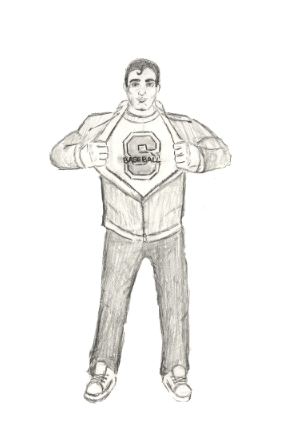
As the snow melts into slush and the first flowers bloom, Staples’ dual season athletes are slowly emerging from a long, cold season of hibernation spent playing indoors as they prepare to venture outdoors for the fast approaching spring season.
“When spring season rolls around, my spirit is set free and soaked up by the sun,” said Erica Stein ’13, a member of both the varsity basketball team and varsity golf team.
Stein is one of the many student athletes who will be making the transition from battling under a roof and dripping sweat onto a hardwood floor to breathing in fresh air and enjoying the outdoors once winter comes to a close and the spring season starts.
“I always look forward to being released from the indoors and being set free to the wild,” said Stein.
However, although the picturesque image of clear skies and unyielding sunshine is ideal, many athletes have come to learn that the greatest benefit of the spring season is also the greatest challenge: playing outdoors.
While the fresh air can be rejuvenating after spending weeks breathing in the dusty air of the field house, the first few weeks of the season are spent in a time when the weather is still jumping between winter and spring, often leaving athletes shivering on the field. And, just as a happy medium is reached, the beating sun intensifies, and dehydration, sweaty misery ensues.
“The weather can drastically affect how you play,” said Fallon Bottone ’13. “For softball the sun can get in the way of you trying to catch a ball that’s in the air. But when it’s really cold it can be harder to throw, catch, or bat because you have to keep your hands warm.”
While the dynamic weather can serve to be a serious burden, many athletes look forward to the added challenge that they must face once they step out from underneath the protection of a roof. Sam Ellinwood ’14 in particular understands that extreme weather can be a distraction on the baseball field and make it harder to focus on the game.
“Some games, I just wish that the weather would be perfect so that I don’t have to worry about it while I’m trying to concentrate on other things,” he said.
But at the same time, Ellinwood sees it as an opportunity to overcome the natural elements.
“It can be really fun to play in rain or windy days because it adds an extra challenge.”
While the outdoors pose physical challenges to athletes, playing indoors comes with its own set of psychological obstacles to tackle. Inside the confines of the gym or field house, every sound is intensified, which can be both exhilarating and exhausting depending on the situation.
“My favorite thing about playing indoors is the crowd and intensity that fills up the gyms during big games, but at the same time this can be my least favorite thing,” Ellinwood said.
Bottone agrees, saying that the typically louder crowds in the winter have their benefits and their drawbacks.
“It creates this great energy, but it can also get really rowdy,” Bottone said.
Overcoming heckling crowds is a right of passage for any indoor athlete, and Ellinwood acknowledges the importance of not letting the crowds become a distraction.
“Having the opposing team’s fans trying to distract you and rattle you throughout the entire game can at times be nerve-racking. But it’s important to mentally overcome the noise of the crowd.”
In addition to the noise, winter athletes need to endure a typically lower level of air quality than they would find outside. Indoor track runners claim to suffer from the infamous “fieldhouse cough,” after spending hours running within the confines of the fieldhouse. Emily Stanford ’14 struggles with breathing normally while playing indoors due to the dry air and problems caused when having to share a gym with a boys team.
“The gym especially usually smells really bad,” she said.
As winter athletes begin to transfer into the spring season, they will be leaving behind one set of challenges and benefits and walking into another. For the true athlete, setting does not matter nearly as much as the sport itself. Eric Zurmuehle ’14 notes the stability of playing indoors and the calming quiet of outdoors but isn’t one to choose favorites.
“Once you get into the game you don’t really notice whether your playing inside or outside,” he said. “You get too involved in the game to care about the temperature because you’re just out there trying to have fun, and nothing else in the world really matters.”











































